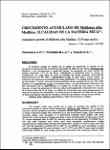Mostrar el registro sencillo del ítem
Crecimiento acumulado de Melilotus alba Medikus II : calidad de la materia seca
Cumulative growth of Melilotus alba Medikus II : Forage quality
| dc.contributor.author | Veneciano, Jorge Hugo | |
| dc.contributor.author | Privitello, Mercedes Liliana Josefa | |
| dc.contributor.author | Terenti, Oscar A. | |
| dc.date.accessioned | 2020-10-23T00:03:29Z | |
| dc.date.available | 2020-10-23T00:03:29Z | |
| dc.date.issued | 1994-12 | |
| dc.identifier.uri | https://repo.unlpam.edu.ar/handle/unlpam/5852 | |
| dc.description.abstract | El presente trabajo se realizó con el objeto de determinar la calidad de las fracciones componentes del crecimiento acumulado de trébol de olor blanco (Melilotus alba Medikus) y sus fluctuaciones a través del tiempo. La evaluación se inició cuando las plantas alcanzaron 16,5 cm de altura, realizándose 8 muestreos hasta el estado de fructificación. En cada fecha se cortó la totalidad del forraje presente, efectuándose determinaciones de PB, FDN y digestibilidad in situ en hoja, tallo y planta entera. Se calcularon las relaciones funcionales entre esos parámetros y la variable independiente 'n° de días desde 1° corte', así como el valor predictivo de las variables (por ciento) de hoja, PB y FDN respecto a la digestibilidad in situ de la planta entera. Los tres parámetros mostraron una alta correlación con la digestibilidad. La calidad de la MS fue alta hasta el inicio de floración. A partir de entonces la misma se redujo acentuadamente, principalmente a causa de la disminución del (por ciento) de hojas. La calidad de la fracción hojas varió escasamente a lo largo de la estación de crecimiento. Se concluye que la utilización del trébol de olor blanco no debe postergarse más allá de iniciada la floración para obtener forraje de alta calidad. | |
| dc.description.abstract | The present study was carried out in order to estimate the quality of the cumulative growth in annual white sweetclover (Melilotus alba Medikus), its component fractions, and its variations over time. Evaluation started when the plants reached 16.5 cm in height (vegetative stage) and continued up to the fructification stage. Eight treatments (sampling dates) were arranged in a randomized complete block design with three replications. Total removal of forage was done at each sampling date. Crude protein % (CP %), neutral detergent fiber % (NDF %), and dry matter in situ digestibility % (DMISD %) of leaf and stem fractions and whole plant were estimated. Mathematical models representing the relationships between the independent variable 'number of days from first cut' and the dependent variables CP %, NDF %, and DMISD % were developed. In each case the correspondent R² was calculated. Leaf %, CP % and NDF % were used to predict whole plant DMISD %. High forage quality was maintained until flowering initiation. After this 5tage was reached, quality decreased with the advance of maturity mainly because of the decrease in leaf %. We conclude that annual white sweetclover should not be utilized after flowering to obtain high quality forage. | |
| dc.format.extent | p. 25-34 | |
| dc.format.medium | application/pdf | |
| dc.language.iso | spa | |
| dc.rights | Atribución-NoComercial-CompartirIgual 2.5 Argentina (CC BY-NC-SA 2.5 AR) | |
| dc.rights.uri | https://creativecommons.org/licenses/by-nc-sa/2.5/ar/ | |
| dc.source.uri | https://repo.unlpam.edu.ar/handle/unlpam/5691 | |
| dc.title | Crecimiento acumulado de Melilotus alba Medikus II : calidad de la materia seca | |
| dc.title | Cumulative growth of Melilotus alba Medikus II : Forage quality | |
| dc.type | artículo | |
| dc.unlpam.instituciondeorigen | Facultad de Agronomía | |
| dc.unlpam.seccion | Artículos | |
| dc.unlpam.access | openAccess | |
| dc.unlpam.version | acceptedVersion | |
| dc.subject.keyword | Melilotus alba medikus | |
| dc.subject.keyword | Annual white sweetclover | |
| dc.subject.keyword | Phenological stages | |
| dc.subject.palabraclave | Melilotus alba medikus | |
| dc.subject.palabraclave | Trébol de olor blanco | |
| dc.subject.palabraclave | Calidad | |
| dc.source.revistaunlpam | Revista de la Facultad de Agronomía. 1994; vol.7 no.2 |
Ficheros en el ítem
Este ítem aparece en la(s) siguiente(s) colección(ones)
-
Semiárida : revista de la Facultad de Agronomía [816]
Revista científica semestral de la Facultad de Agronomía, UNLPam.











